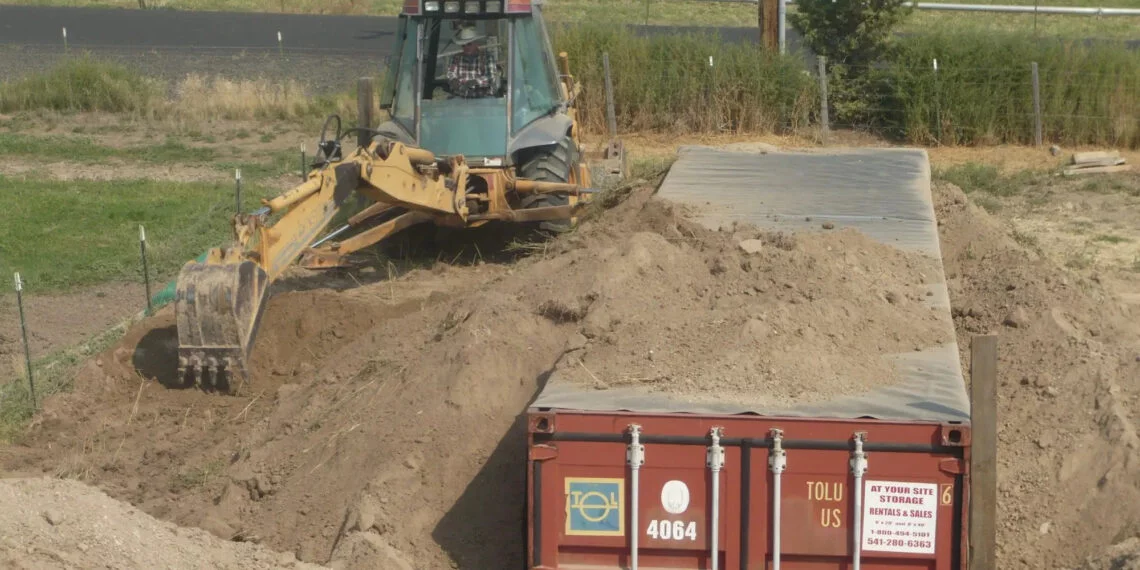Burying Shipping Containers: Safety, Reinforcement, and Uses
Burying a shipping container intrigues many individuals searching for a cost-effective solution for subterranean storage or shelter.
At first glance, shipping containers appear robust and ready-made for such purposes due to their sturdy construction and ease of modification and transportation
However, the reality of burying these containers is more complex than it seems. Their structural integrity is designed primarily for bearing vertical loads on their corner posts, not for withstanding the lateral pressures exerted by surrounding soil.
Without proper reinforcement, a buried shipping container risks collapse under the weight of the earth, especially over time.
This article explores the considerations, challenges, and procedures involved in safely burying a shipping container.
Understanding Shipping Containers
Shipping containers are pivotal in global transport and storage, crafted from durable materials to endure harsh conditions.
They represent a standardized format for shipping a wide range of goods across land and sea.
Characteristics of Containers
Shipping containers are primarily constructed from corrosion-resistant steel to withstand the elements and heavy loads.
They typically weigh between 1.8 and 4.2 tons, depending on their size and build. These containers are designed with standardized measurements to ensure compatibility across various transportation modes, including cargo ships, trucks, and trains.
Types and Sizes
The most common types of shipping containers are 20-foot and 40-foot variants:
20-Foot Container (TEU): Measures 20 feet long, 8 feet wide, and 8.6 feet high.
40-Foot Container (FEU): Doubles the length of the TEU without altering the width or height, providing twice the volume.
Other variations include high-cube containers, which offer increased internal height for tall cargo, and specialized units such as refrigerated containers for temperature-sensitive items.
These containers offer flexible solutions for various shipping needs.

Planning Your Burial Project
When considering burying a shipping container, thorough assessment of legal frameworks, site selection, and design is crucial. This ensures adherence to regulations and functional safety.
Legal Considerations
Before starting your project, obtaining necessary permissions is essential. Investigate local and state zoning laws related to burying structures.
Some regions may require specific approvals or outright prohibit the practice, which can significantly affect the project’s feasibility.
Site Selection
Optimal site selection involves analyzing soil type and water table levels, as these factors influence the container’s integrity when buried.
Conduct a soil test to ensure the site can support the added weight and pressure. Accessibility is another key factor, as the site must be reachable by trucks transporting the container and excavation equipment.
Designing Your Burial Space
Designing the buried space involves addressing the structural limitations of shipping containers.
Since containers are not built to withstand lateral soil pressure, reinforcement is necessary to prevent collapse.
Consider how access points and escape routes will be integrated, ensuring they meet safety standards.

Construction and Reinforcement
Modifying a shipping container for underground use requires reinforcement to handle significant pressure from surrounding soil. Neglecting this step can result in structural failure.
Reinforcing Techniques
Reinforcement typically involves welding steel bars along the interior, focusing on areas prone to pressure, such as the roof and sides.
Additionally, reinforcing the wooden floor with concrete adds rigidity and helps distribute weight evenly.
Addressing Pressure Issues
Lateral pressure from soil, especially when moist, can cause the container’s sidewalls to buckle.
Reinforcements like cross beams can help distribute this pressure more evenly, reducing the risk of collapse.
Use of Gabion Baskets
Gabion baskets filled with stones can be placed around the container to distribute pressure.
These external reinforcements stabilize the structure and prevent inward collapse by managing the load from surrounding soil.
Potential Uses for Buried Containers
Buried shipping containers offer versatile solutions for various needs, ranging from emergency shelters to innovative living spaces.
Survival and Security
Converted into survival bunkers or storm shelters, buried containers provide secure spaces during extreme weather events or emergencies.
In SHTF (“shit hits the fan”) scenarios, a reinforced container bunker can offer protection from various threats.
Storage Solutions
As underground storage units, buried containers are ideal for maintaining consistent temperature and humidity levels, making them suitable for storing crops, wine, or other perishables.
They can also serve as secure storage for important documents or valuables, protecting them from theft and natural disasters.
Alternative Living Spaces
For those exploring alternative living, buried containers can be transformed into unique, eco-friendly homes.
With proper reinforcement and modification, these subterranean homes offer thermal efficiency due to the surrounding earth’s insulation.
However, structural supports and waterproofing techniques are necessary to ensure long-term stability and habitability.

Safety and Maintenance
Safety and maintenance are critical when burying a shipping container. The integrity of the container is at risk during and after burial due to specific challenges that require consistent upkeep.
Risks and Dangers
The primary danger is potential collapse under soil weight, as containers are not designed to withstand side or top pressure.
This collapse poses significant risks to anyone inside or near the structure. Additionally, the enclosed space can foster rust and mold growth, compromising structural integrity and posing health hazards.
Structural Maintenance
Regular structural maintenance includes reinforcing the roof and walls to distribute soil weight.
Additional support beams can be installed around the corner posts to enhance durability.
Ongoing inspection and addressing rust and mold with protective coatings and adequate ventilation are crucial.

Technologies for Added Protection
Employing specific technologies can enhance a buried container’s longevity and safety, making it more suitable for storage or habitation.
Creating a Faraday Cage
A Faraday cage shields the container’s contents from electromagnetic pulses (EMPs) by dispersing energy along its exterior.
Copper mesh or braiding envelops the container and is grounded to function effectively. This EMP-proofing requires meticulous installation to prevent electrical penetration.
Sealing and Insulation
High-quality sealing prevents moisture ingress, and insulation maintains internal temperature stability.
Common insulation materials include foam or fiberglass, which also add structural rigidity.
Additional Modifications
Additional modifications for stability and functionality include:
Welding: Strengthening weak points at seams and joints.
Reinforcing: Installing steel beams or supports to maintain shape under soil pressure.
Communication: Integrating communication lines protected against EMP and other interferences.
Summary
Burying a shipping container can provide a cost-effective solution for underground storage or shelter, but it requires careful planning, legal compliance, structural reinforcement, and ongoing maintenance.
By addressing these factors, a buried container can serve various purposes, from secure storage to alternative living spaces, offering durability and protection beneath the earth.






